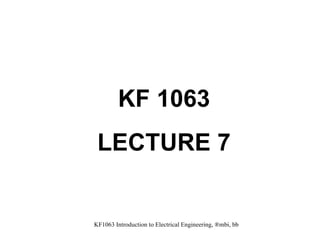
Lecture7
- 1. KF1063 Introduction to Electrical Engineering, ®mbi, bb KF 1063 LECTURE 7
- 4. Z = R (purely resistive) KF1063 Introduction to Electrical Engineering, ®mbi, bb ACTIVE POWER P = VI = I 2 R = V 2 / R (Watt)
- 8. KF1063 Introduction to Electrical Engineering, ®mbi, bb Determine the total P T and Q T for the circuit. Sketch the series equivalent circuit. R = P T / I 2 = 1200/20 2 = 3 X eq = X L = Q T / I 2 = 1600/20 2 = 4 ACTIVE/REACTIVE POWER - Example
- 9. KF1063 Introduction to Electrical Engineering, ®mbi, bb For load consisting of series resistance and reactance, Z = R j X = Z / θ , the power produced is called Apparent Power or Complex Power ), S or P S with unit Volt-Amp (VA) APPARENT POWER θ positive, inductive load θ negative, capacitive load S = VI (VA) P = VI kos θ = I 2 R = V R 2 /R (W) = S kos θ (W) Q = VI sin θ = I 2 X = V x 2 / X (VAR) = S sin θ S = ( P 2 + Q 2 ) = VI * V /0 Power Triangle S = P + j Q L S = P – j Q C S = VI S = VI
- 10. KF1063 Introduction to Electrical Engineering, ®mbi, bb POWER TRIANGLE - Example Sketch the power triangle.
- 12. Leading p.f. (final) = cos θ J ; Q J = P tan θ J Q C = Q – Q J Q C = V 2 / X C ; X C = 1/ j C = V 2 / Q C KF1063 Introduction to Electrical Engineering, ®mbi, bb POWER FACTOR - Correction
- 13. Figure 7.18, 7.19, 7.20 KF1063 Introduction to Electrical Engineering, ®mbi, bb Given: V s = 117 0 V, R L = 50 , j X L = 86.7 = 377 rad/s Z L = 50 + j86.7 = 100 1.047 I L = V L / Z L = (117 0 )/(100 1.047) = 1.17 – 1.047 A S = V L I L * = 137 1.047) = 68.4 + j118.5 VA Q C = – 118.5 VAR X C = V L 2 /118.5 = – j115 C = 1/ X c = 23.1 F Find the complex power for the circuit. Correct the circuit power factor to p.f. = 1 using parallel reactance. POWER FACTOR - Example
- 14. KF1063 Introduction to Electrical Engineering, ®mbi, bb POWER MEASUREMENT Wattmeter only reads active power on the load side
- 15. KF1063 Introduction to Electrical Engineering, ®mbi, bb POWER MEASUREMENT - Example What is the reading of wattmeter, W? P T = 10 + 40 + 700 = 750 W
- 16. KF1063 Introduction to Electrical Engineering, ®mbi, bb P.F. MEASUREMENT - Example S = VI = (9.615)(240) = 2.308 kVA p.f. = 1.5 kW/2.308 kVA = 0.65 Q = 1.754 kVAR If p.f. = 1 (correction) X c = V 2 / Q then C = 80.761 F What happen if C = 80 F?
